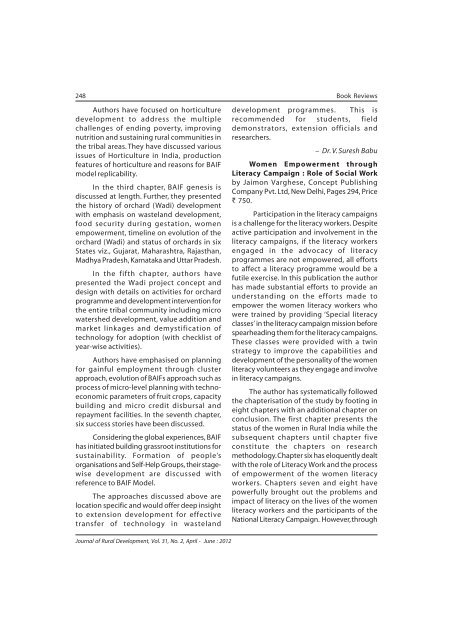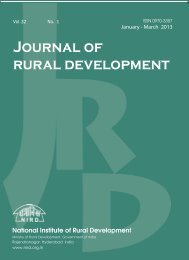contents - National Institute of Rural Development
contents - National Institute of Rural Development
contents - National Institute of Rural Development
Create successful ePaper yourself
Turn your PDF publications into a flip-book with our unique Google optimized e-Paper software.
248 Book Reviews<br />
Authors have focused on horticulture<br />
development to address the multiple<br />
challenges <strong>of</strong> ending poverty, improving<br />
nutrition and sustaining rural communities in<br />
the tribal areas. They have discussed various<br />
issues <strong>of</strong> Horticulture in India, production<br />
features <strong>of</strong> horticulture and reasons for BAIF<br />
model replicability.<br />
In the third chapter, BAIF genesis is<br />
discussed at length. Further, they presented<br />
the history <strong>of</strong> orchard (Wadi) development<br />
with emphasis on wasteland development,<br />
food security during gestation, women<br />
empowerment, timeline on evolution <strong>of</strong> the<br />
orchard (Wadi) and status <strong>of</strong> orchards in six<br />
States viz., Gujarat, Maharashtra, Rajasthan,<br />
Madhya Pradesh, Karnataka and Uttar Pradesh.<br />
In the fifth chapter, authors have<br />
presented the Wadi project concept and<br />
design with details on activities for orchard<br />
programme and development intervention for<br />
the entire tribal community including micro<br />
watershed development, value addition and<br />
market linkages and demystification <strong>of</strong><br />
technology for adoption (with checklist <strong>of</strong><br />
year-wise activities).<br />
Authors have emphasised on planning<br />
for gainful employment through cluster<br />
approach, evolution <strong>of</strong> BAIFs approach such as<br />
process <strong>of</strong> micro-level planning with technoeconomic<br />
parameters <strong>of</strong> fruit crops, capacity<br />
building and micro credit disbursal and<br />
repayment facilities. In the seventh chapter,<br />
six success stories have been discussed.<br />
Considering the global experiences, BAIF<br />
has initiated building grassroot institutions for<br />
sustainability. Formation <strong>of</strong> people’s<br />
organisations and Self-Help Groups, their stagewise<br />
development are discussed with<br />
reference to BAIF Model.<br />
The approaches discussed above are<br />
location specific and would <strong>of</strong>fer deep insight<br />
to extension development for effective<br />
transfer <strong>of</strong> technology in wasteland<br />
Journal <strong>of</strong> <strong>Rural</strong> <strong>Development</strong>, Vol. 31, No. 2, April - June : 2012<br />
development programmes. This is<br />
recommended for students, field<br />
demonstrators, extension <strong>of</strong>ficials and<br />
researchers.<br />
– Dr. V. Suresh Babu<br />
Women Empowerment through<br />
Literacy Campaign : Role <strong>of</strong> Social Work<br />
by Jaimon Varghese, Concept Publishing<br />
Company Pvt. Ltd, New Delhi, Pages 294, Price<br />
` 750.<br />
Participation in the literacy campaigns<br />
is a challenge for the literacy workers. Despite<br />
active participation and involvement in the<br />
literacy campaigns, if the literacy workers<br />
engaged in the advocacy <strong>of</strong> literacy<br />
programmes are not empowered, all efforts<br />
to affect a literacy programme would be a<br />
futile exercise. In this publication the author<br />
has made substantial efforts to provide an<br />
understanding on the efforts made to<br />
empower the women literacy workers who<br />
were trained by providing ‘Special literacy<br />
classes’ in the literacy campaign mission before<br />
spearheading them for the literacy campaigns.<br />
These classes were provided with a twin<br />
strategy to improve the capabilities and<br />
development <strong>of</strong> the personality <strong>of</strong> the women<br />
literacy volunteers as they engage and involve<br />
in literacy campaigns.<br />
The author has systematically followed<br />
the chapterisation <strong>of</strong> the study by footing in<br />
eight chapters with an additional chapter on<br />
conclusion. The first chapter presents the<br />
status <strong>of</strong> the women in <strong>Rural</strong> India while the<br />
subsequent chapters until chapter five<br />
constitute the chapters on research<br />
methodology. Chapter six has eloquently dealt<br />
with the role <strong>of</strong> Literacy Work and the process<br />
<strong>of</strong> empowerment <strong>of</strong> the women literacy<br />
workers. Chapters seven and eight have<br />
powerfully brought out the problems and<br />
impact <strong>of</strong> literacy on the lives <strong>of</strong> the women<br />
literacy workers and the participants <strong>of</strong> the<br />
<strong>National</strong> Literacy Campaign. However, through

















